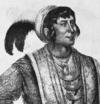- Osceola
-
/os'ee oh"leuh, oh'say-/, n.1804-38, U.S. Indian leader: chief of the Seminole tribe.
* * *
died Jan. 30, 1838, Charleston, S.C.The war began in 1835 when the U.S. government attempted to force the Seminole off their traditional lands in Florida and into the Indian territory west of the Mississippi River. Osceola and his followers employed guerrilla tactics and forced a truce. During negotiations he was arrested and removed to a military fort at Charleston, S.C., where he died. Osceola, detail of a lithograph by George Catlin, 1838By courtesy of the Library of Congress, Washington, D.C.
Osceola, detail of a lithograph by George Catlin, 1838By courtesy of the Library of Congress, Washington, D.C.* * *
city, southern seat (1832) of Mississippi county (the northern seat is Blytheville), northeastern Arkansas, U.S., on the Mississippi River, about 50 miles (80 km) north of Memphis, Tennessee. It was founded in 1830 by William B. Edrington, who bartered the site (probably Plum Point) from the Indians and developed it as a refueling station for riverboats. It was named for Osceola, the famed Seminole chief, and developed as a processing and shipping point for crops (especially cotton and, later, soybeans) grown on rich alluvial deposits from the Mississippi.The manufacture of greeting cards, clothing, automotive products, processed foods, and metal specialty products forms the basis of the economy. Hampson Museum State Park is on the river 9 miles (14 km) south of Osceola, while Big Lake National Wildlife Reserve, covering 17 square miles (45 square km), is about 20 miles (32 km) to the northwest. Inc. 1837. Pop. (1990) 8,930; (2000) 8,875.▪ Seminole leaderborn c. 1804, Georgia, U.S.died Jan. 30, 1838, Charleston, S.C.American Indian leader during the Second Seminole War, which began in 1835 when the U.S. government attempted to force the Seminole Indians off their traditional lands in Florida and into the Indian territory west of the Mississippi River.Osceola moved from Georgia to Florida, where, although not a chief, he came to be acknowledged as a leader of the Seminoles. He led the young Indians who opposed the Treaty of Payne's Landing (1832), by which some of the Seminole chiefs agreed to submit to removal from Florida. In 1835 he and a group of braves murdered Charley Emathla, a chief who was preparing to emigrate with his people, and Gen. Wiley Thompson, the U.S. Indian agent at Ft. King.For the next two years, U.S. troops attempted to crush Seminole opposition. The Indians withdrew into the Everglades and fought back, employing guerrilla tactics. In October 1837 Osceola and several chiefs went to St. Augustine, Fla., under a flag of truce to attend a parley with Gen. T.S. Jesup. By special order of the General, the Indians were seized and imprisoned. Osceola was removed to Ft. Moultrie at Charleston, S.C., where he died. The war continued until 1842, but only sporadically after Osceola's death.* * *
Universalium. 2010.
